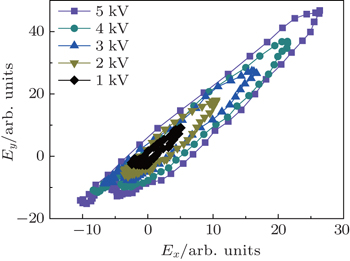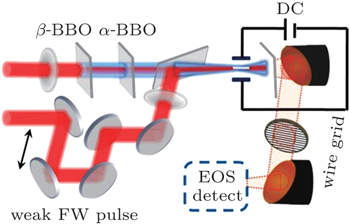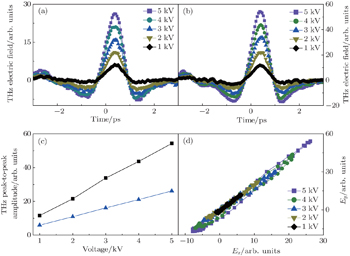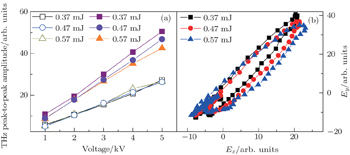† Corresponding author. E-mail:
Project supported by the National Key Scientific Instrument Project, China (Grant No. 2012YQ150092), the National Basic Research Program of China (Grant No. 2011CB808105), the National Natural Science Foundation of China (Grant No. 11434005), the China Postdoctoral Science Foundation (Grant No. 2014M560348), and the Fund from the Shanghai Municipal Science and Technology Commission, China (Grant No. 14JC1401600).
Terahertz generation driven by dual-color filaments in air is demonstrated to be remarkably enhanced by applying an external electric field to the filaments. As terahertz generation is sensitive to the dual-color phase difference, a preformed plasma is verified efficiently in modulating terahertz radiation from linear to elliptical polarization. In the presence of preformed plasma, a dual-color filament generates terahertz pulses of elliptical polarization and the corresponding ellipse rotates regularly with the change of the preformed plasma density. The observed terahertz modulation with the external electric field and the preformed plasma provides a simple way to estimate the plasma density and evaluate the photocurrent dynamics of the dual-color filaments. It provides further experimental evidence of the photo-current model in governing the dual-color filament driven terahertz generation processes.
In recent years, optimization of the terahertz (THz) generation has received much attention due to its significant applications in imaging, sensing and nonlinear THz spectroscopy.[1] The laser-produced plasma scheme has been a potential and effective method to provide sufficiently powerful far-field THz waves.[2–4] Furthermore, an external electric field has been applied to the single-color filament to enhance the THz intensity. Through this method, a THz electric field parallel to the direction of an external electric field is increased obviously.[5–7] It is well confirmed that THz radiation could be generated from a time-dependent drifting current induced by an asymmetric laser field of dual-color pulse.[8–10] The generated THz intensity and polarization could be modulated by controlling the phase difference and intensities of the dual-color pulses because of its highly nonlinear and phase-sensitive features.[11–16] In this sense, dynamic control of the drifting electrons in the plasma is important for controlling the THz intensity and polarization state. The time- or frequency-characteristics of THz radiation could also be modulated by varying the drifting electrons. This research provides theoretical basis and technical support for precise imaging and spectrum analysis in the THz range.
In this paper, an external dc-biased electric field is used to increase the drifting current by accelerating electrons in the plasma. Compared with the THz radiation driven by a single-color filament, an arbitrary polarization component of the THz radiation is enhanced dramatically with the increase of the external electric field. In addition, the refractive index of air presents a gradient distribution with the existence of preformed plasma. The phase difference between dual-color pulses changes as they pass through the preformed plasma, leading to the elliptically polarized THz radiation. Furthermore, the ellipticity and polarization ellipse are modulated regularly with the cooperation of these two effects. On the other hand, the preformed plasma density could be estimated from the THz polarization state change induced by the preformed plasma.
The experiments were done with a Ti: sapphire amplifier operated at 800 nm with a repetition rate of 1 kHz. The fundamental-wave (FW) pulses with an output pulse energy of 2.3 mJ and a pulse duration of 50 fs were split into two pulses by a 2:1 beam splitter (Fig.
According to the photo-current mode proposed by Kim et al., the drifting electrons accelerated by the asymmetric electric field of the dual-color pulses form a transverse plasma current J⊥ = eNeυe, leading to the THz generation.[17,18] In our experiment, besides the acceleration from the asymmetric electric field, the external electric field also accelerates the drifting electrons. Therefore, the electron velocity υe under the dual-color pulse laser field and external electric field can be expressed as

Firstly, an external electric field parallel to the s direction is applied to the dual-color filament in the absence of a weak-800 nm pulse. With no external electric field applied, the drifting electrons are accelerated by two orthogonal laser fields from dual-color pulses. The generated THz radiation is linearly polarized with a fixed angle with respect to the p direction. With an external electric field applied, its electric field contributing to the acceleration of electrons along the s and p directions can be expressed as Ex = EDC sin α cos α and Ey = EDC sin2 α in the x and y directions, respectively, where EDC is the amplitude of the external electric field, α is the angle between the THz polarization and p polarization direction. Therefore, the drifting electrons are both accelerated along the two orthogonal directions, leading to the enhancement of two orthogonal components of THz radiation as shown in Figs. 
A pre-formed plasma is generated by a focused weak 800-nm pulse polarized in parallel to the direction of the external electric field, which can be used to influence the dual-color filament. The polarization scenarios of the generated THz are shown in Fig.
 | Fig. 3. Measured THz polarization states at different external electric fields with 0.47-mJ FW pulse energy. |
For the elliptically polarized laser, the polarization ellipse is related to phase difference and the electric field ratio of the orthogonal laser fields. In the experiment, the phase difference between dual-color pulses is constant with a certain plasma density, and the ratio of two orthogonal components keeps constant with the increase of the external electric field. Therefore, the polarization ellipse of generated THz is along the same direction, while the intensity of the generated THz increases with an external electric field at a certain plasma density.
In addition, the THz peak-to-peak amplitudes along the s and p directions are measured as the weak 800-nm pulse energy is adjusted from 0.37 mJ to 0.57 mJ under the condition of a fixed external electric field. The change of the THz peak-to-peak amplitude with the external electric field along the p direction is independent of the weak 800-nm pulse energy. However, as shown in Fig.
In this paper, we demonstrate that THz generation from dual-color pulse filaments is regularly modulated by an external electric field. The two components of the THz electric field increase with the enhancement of the external electric field. The THz polarization is modulated from linear polarization to an elliptical one. Meanwhile, the rotation of the THz polarization can also be achieved by adjusting the weak-800 nm pulse energy. All the experimental results can be explained well according to the photo-current model, thereby providing an effective method to prove the THz generation mechanism.
| 1 | |
| 2 | |
| 3 | |
| 4 | |
| 5 | |
| 6 | |
| 7 | |
| 8 | |
| 9 | |
| 10 | |
| 11 | |
| 12 | |
| 13 | |
| 14 | |
| 15 | |
| 16 | |
| 17 | |
| 18 | |
| 19 |





